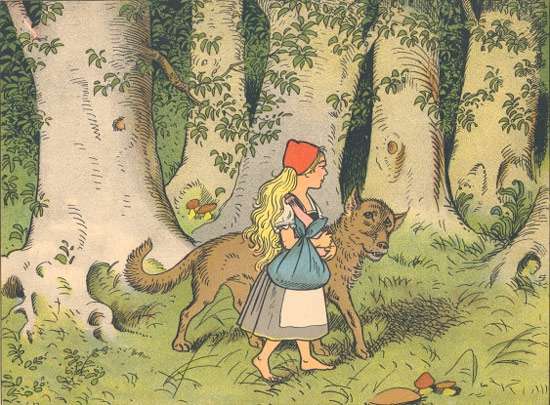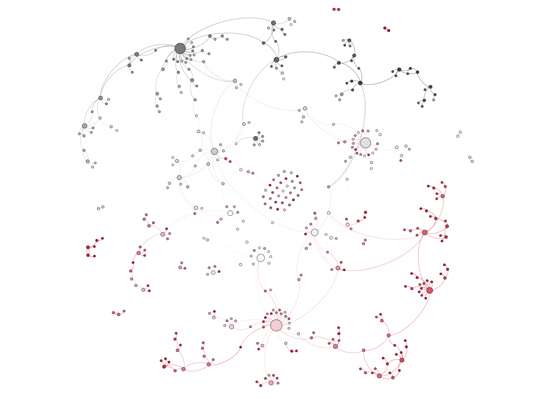Illustration from Roodkapje, een sprookje in plaatjes (1907), by L. Meggendorfer. The book is a Grimm version with humorous illustrations in which Red Riding Hood’s father frees the hunter, the grandmother and Red Riding Hood, and the wolf drowns in the well.
A computer analysis of the texts of more than 400 Dutch versions of Little Red Riding Hood from the 18th century up to now provides more insight into the evolution of this fairy tale. The computational ethnologist Folgert Karsdorp and the language technologist Antal van den Bosch of Radboud University studied the story and the way in which the various versions form a network with one another.
Karsdorp and Van den Bosch show that each new text gradually alters the fairy tale and almost always refers back to its immediate predecessors. Roughly speaking, this happens about once every 20 years.
Relationships
Van den Bosch: "We wanted to find an explanation for the way in which a network of stories arose and grew, how you can discover relationships and why certain versions prevail."
The researchers were able to find empirical support for some mechanisms that applied to the dispersion of Little Red Riding Hood. Karsdorp: "A text already used by many authors will also be used more often by others." Another factor was the appeal of a text, for example because of strange or striking elements or the author's fame. "But this appeal diminishes with time."
Original versions
All of the versions ultimately refer back to two original versions: the German version by the Brothers Grimm and the French version by Charles Perrault. Karsdorp: "The German version is primarily a story for children with the underlying message that you should always listen to your parents. The French version is just as moralistic, but it was intended more for the young women at the court of Versailles in the 17th century to warn them of sweet-talking, two-legged wolves." Perrault warned the women for seducers. His is a rougher version, hinting at rape and without a happy ending; unlike the version by the Brothers Grimm, there is no hunter to save Little Red Riding Hood.
The network of versions of Little Red Riding Hood. The colour of the dots indicates the age of the text (ranging from black (oldest) via white to red (youngest)). The size of the dots indicates how often a text was used as an inspiration for a new version. Credit: Radboud University
Four hundred versions
The researchers used a very special source: all of the scanned or manually transcribed texts of more than 400 Dutch versions of Little Red Riding Hood in the collection of the National Library of the Netherlands and digitalised by Karsdorp in collaboration with the Meertens Institute in Amsterdam. Van den Bosch: "The computer enabled us to research a large corpus with so much data for one text, something you could never have done manually. This is a much more effective way of studying how texts are related."
More information: Folgert Karsdorp et al. The structure and evolution of story networks, Royal Society Open Science (2016). DOI: 10.1098/rsos.160071
Journal information: Royal Society Open Science
Provided by Radboud University





















